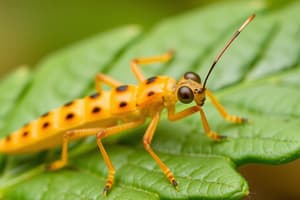Podcast
Questions and Answers
What are the common characteristics of living things?
What are the common characteristics of living things?
Made up of a common set of chemicals, cells enclosed by a plasma membrane, molecules from environment create new biomolecules, energy from environment is used for biological work, universal genetic code specifies proteins, similar fundamental set of genes that replicate, exist in populations that evolve, self regulate internal environment.
How do we know all living things are genetically related?
How do we know all living things are genetically related?
Life has a common ancestry, all organisms descended from a common origin, and similarities exist across gene sequences.
How do you correctly assign electrons to their electron shells?
How do you correctly assign electrons to their electron shells?
Atomic number equals the number of protons and electrons; the first shell holds 2 electrons; the second holds 8.
Define isotopes and their significance.
Define isotopes and their significance.
What is the octet rule?
What is the octet rule?
Which types of covalent bonds are there?
Which types of covalent bonds are there?
What is an ion?
What is an ion?
How is an ionic bond formed?
How is an ionic bond formed?
Explain why salt dissolves in water.
Explain why salt dissolves in water.
What are hydrogen bonds?
What are hydrogen bonds?
Compare the relative strengths of covalent bonds, ionic bonds, hydrogen bonds, and van der Waals forces.
Compare the relative strengths of covalent bonds, ionic bonds, hydrogen bonds, and van der Waals forces.
Define hydrophilic.
Define hydrophilic.
Define hydrophobic.
Define hydrophobic.
What are hydrophobic interactions?
What are hydrophobic interactions?
List properties of water due to hydrogen bonds.
List properties of water due to hydrogen bonds.
Explain why ice floats.
Explain why ice floats.
What does the pH scale measure?
What does the pH scale measure?
Flashcards are hidden until you start studying
Study Notes
Common Characteristics of Living Things
- Comprised of proteins, lipids, carbohydrates, and nucleic acids.
- Cells are enclosed by a plasma membrane.
- Utilize environmental molecules to form new biomolecules.
- Obtain energy from the environment to perform biological work, such as photosynthesis.
- Genetic code is universal, dictating protein production.
- Similar fundamental gene sets exist across all life forms, facilitating replication.
- Organisms exist in evolving populations.
- Maintain homeostasis through self-regulation of internal environment.
Genetic Relationships Among Living Things
- All life shares a common ancestry, derived from a singular origin.
- Striking genetic similarities manifest across diverse organisms, suggesting common descent.
Atomic Structure and Bonding
- Electrons equal protons in neutral atoms, determining atomic number found in the top left corner.
- Mass number, reflected in decimal form, indicates total number of protons and neutrons.
- Neutron count is calculated by subtracting the atomic number from the mass number.
- Electron shells: the first shell holds 2 electrons, while the second holds 8.
Isotopes and Their Significance
- Isotopes are variations of an element that differ in neutron count, leading to different mass numbers.
- Useful in determining the weighted average atomic mass.
Covalent Bonding and the Octet Rule
- Atoms typically form bonds to achieve 8 electrons in their outermost shell, promoting stability.
- Octet rule explains the tendency to create stable molecular structures through shared electrons.
Polar vs. Nonpolar Covalent Bonds
- Covalent bonds involve sharing of electron pairs, crucial for atom stability.
- Nonpolar bonds: equal sharing between atoms of the same element or similar electronegativity.
- Polar bonds: unequal sharing due to differences in electronegativity (e.g., water).
Ions: Formation and Recognition
- Ions are electrically charged atoms/molecules due to the loss or gain of electrons.
- Cations carry a positive charge by losing electrons (e.g., Na⁺).
- Anions carry a negative charge by gaining electrons (e.g., Cl⁻).
Ionic Bonds Formation
- Ionic bonds form through electrostatic attraction between oppositely charged ions (e.g., metal + nonmetal).
- Generally weaker than covalent bonds and commonly observed among elements.
Salt Dissolving in Water
- Polar water molecules interact with ionic compounds, disrupting ionic bonds and leading to dissolution.
Hydrogen Bonds
- Formed between hydrogen atoms covalently bonded to electronegative atoms (F, O, N) and other electronegative atoms.
- Weaker than ionic bonds, these interactions are crucial for many biological processes.
Relative Strengths of Bonds
- Strength hierarchy: covalent > ionic > hydrogen > van der Waals forces.
Hydrophilic and Hydrophobic Molecules
- Hydrophilic: "water-loving" molecules with polar covalent bonds; they interact well with water.
- Hydrophobic: "water-fearing" molecules with nonpolar covalent bonds that prefer interactions with similar molecules over water.
Hydrophobic Interactions
- Occur when water molecules force hydrophobic groups to cluster together due to unfavorable interactions with water.
Water Chemistry and Properties
- High heat of vaporization allows cooling through the evaporation of sweat.
- Surface tension allows organisms to avoid sinking due to cohesive water molecule behavior.
- Cohesion aids in water transport in plants from roots to leaves.
Ice Floats and Its Ecological Benefits
- Ice's lower density compared to liquid water arises from hydrogen bonding arrangements, providing insulation for aquatic life.
pH Scale
- Measures the concentration of hydrogen ions in a solution, indicating acidity or alkalinity.
Studying That Suits You
Use AI to generate personalized quizzes and flashcards to suit your learning preferences.



